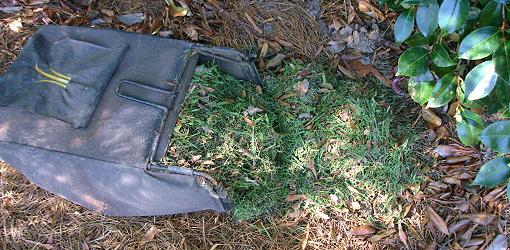

During one of these years, the effects of mulching with grass‐clippings on root fly population dynamics was also studied. Mulching with grass‐clippings consistently resulted in increased yield and reduced damage by root maggots, as measured by wilting symptoms and root damage. radicum) in cauliflower, were studied in field experiments for 3 years.
#MULCH GRASS CLIPPINGS FREE#
Use the cut grass left over from mowing as free mulch that keeps your garden happier and healthier the natural way.The effects of mulching with organic materials on yield and damage by brassica root maggots (Delia floralis and D. Additionally, any weed seeds that enter the garden will be trapped in the mulch, preventing them from reaching the soil where they can sprout and take root. The mulch barrier smothers weed seeds that sprout, killing them before they break through and reach the sun. If used as mulch, weed-free grass clippings suppress weed growth in gardens. If the grass clippings are piled near the base of your plants, the heat they release can damage roots, stems, and leaves. Grass clippings that have just been through your mower blades will release a lot of heat as they go through the initial drying stages. Similarly, do not use fresh grass clippings as mulch. Weedy grass used as mulch can introduce lawn weeds into your garden. Weeds in the grass clippings can drop weed seeds in the garden and cause more harm than good. If your lawn has a lot of weeds, don’t use the grass clippings to mulch your garden. Avoid using fresh grass clippings as mulch.Do not spread grass clippings from a weedy yard in your garden bed.If your grass has been treated with herbicide in the last 2 months, do not spread it in your garden.If you use lawn clippings that were recently sprayed with a herbicide that kills broadleaf weeds, you run the risk of killing the plants in your garden by introducing herbicides. Systemic herbicides used to kill weeds attack broadleaf plants, meaning they kill both weeds and garden plants. Mistakes to Avoid When Using Grass Clippings to Stop Weedsĭo not use grass clippings as mulch if your lawn has been treated with herbicide in the last 60 days.

Just make sure none of your garden plants are buried beneath the mulch layer. Established perennial weeds, such as dandelion, may find a way to survive and poke through the mulch. Small annual weeds will be smothered by mulch and die. They may be smothered.Ī 3–4 inch layer of grass clippings will serve as an effective weed barrier that keeps new weed growth from invading your garden.

#MULCH GRASS CLIPPINGS HOW TO#
How to Use Grass Clippings as Weed-Stopping Mulch Lawn clipping mulch performs a dual purpose as garden fertilizer and mulch. As your grass mulch layer breaks down over the course of 2–3 months, it will return these nutrients to the soil. They contain 4% nitrogen, 1% phosphorus, and 2% potassium. Grass blades are the equivalent of a slow-release fertilizer. As it decomposes, the organic materials in the mulch layer feed your garden. Grass clipping mulch helps retain soil moisture to reduce watering needs.The mulch layer prevents any weed seeds that blow into the garden from reaching the soil and taking root.A 3–4 inch deep layer of mulch stops weeds from sprouting your garden.Grass clippings make an excellent garden mulch.Grass clipping mulch not only suppresses weeds, but also helps the soil retain moisture, insulates the ground against intense heat and cold, and gradually decomposes, returning organic matter to the soil. The grass clippings produced by mowing can be repurposed as excellent garden mulch. Mistakes to Avoid When Using Grass Clippings to Stop WeedsĬan You Use Grass Clippings as Mulch to Stop Weeds?.How to Use Grass Clippings as Weed-Stopping Mulch.Can You Use Grass Clippings as Mulch to Stop Weeds?.


 0 kommentar(er)
0 kommentar(er)
